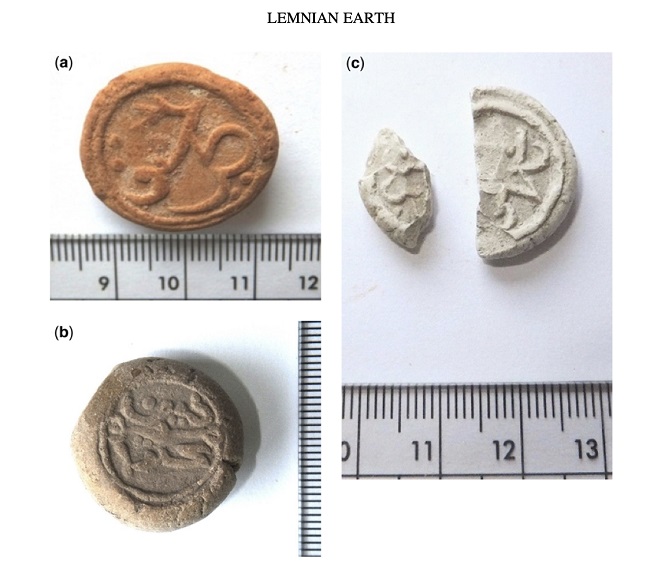Ancient clay remedy may have potential to boost modern gut health
Published: 17 December 2024
A team of scientists has discovered that an ancient medicinal clay known as Lemnian Earth (LE) could inspire new understanding of how to support present-day gut health
A team of scientists has discovered that an ancient medicinal clay known as Lemnian Earth (LE) could inspire new understanding of how to support present-day gut health.
The team also think that that LE was probably the prototype for the modern medicinal pill as far back as the 1st millennium, before the Common Era (BCE), since it was shaped into a small pellet, stamped with a seal and taken with liquids such as wine.

This new study, by researchers from the University of Glasgow, University of Strathclyde, and the Technical University of Crete, points to the possibility that its healing properties were the result of a deliberate combination of specific clays with certain fungi.
The research, published in PLOS One, suggests that combining some clays with beneficial fungi may produce compounds that positively impact gut bacteria, which could help maintain a balanced gut microbiome - a key factor in overall wellness.
The paper says: “Regarding the LE, the precise recipe for its preparation remains, and is likely to remain, unclear and further, it may have been modified over time. Investigating LE, and what has been known about it, has served as a springboard to investigate the modulation of the microbiome in a targeted fashion.
“Our data provide a potential mechanism by which fungus + clay co-cultures may be a valuable tool for manipulating the microbiota to prevent the progression of inflammatory diseases, and perhaps also limit intestinal infections; it therefore suggests avenues for the further development of ancient LE’s potential in a 21st century context.”
For over 2,500 years Lemnian Earth has been revered as a medicine to protect against poisons ingested or injected and, in the post-medieval period even against the plague.
Dr Effie Photos-Jones, an archaeological scientist from the School of Humanities at the University of Glasgow, and the project’s lead investigator, said: “Our study began many years ago on the island of Lemnos in the northern Aegean, Greece. By examining historical LE samples (16th-18th Common Era) from Basel University’s Museum of Pharmacy we found that these samples contained specific types of fungi which were not present in the natural Lemnos clay.
“This led us to wonder if they were part of the original recipe. Ancient texts mention a ‘blessing’ ritual involving wheat and barley, suggesting that these grains – often infected during storage with certain fungi - might have been intentionally added. Speculating on this led, to our knowledge, the first ever attempt to establish the presence and nature of microorganisms (bacteria, fungi) within ancient mineral therapeutics (DNA sequencing), following an approach developed by Dr Charles Knapp at Strathclyde University.”
After examining historical LE samples from Basel University, the team grew their own fungus and clays (one a smectite-rich clay*, and another using a kaolinite-rich clay**) together in a controlled environment to allow the creation of bioactive compounds.
Professor Simon Milling, Professor of Immunology, Centre for Immunobiology, School of Infection & Immunity, University of Glasgow added: “Our reconfigured 21st century Lemnian Earth shows that this ancient remedy has the potential to support good gut health for people living today.”
Testing by the researchers showed that the combination of smectite clay and fungus had broad antibacterial properties and uniquely positive effects on the gut microbiome.
Professor Danae Venieri, School of Chemical and Environmental Engineering, Technical University of Crete, said: “The results were very interesting. Testing against common pathogens showed that the combination of smectite clay and fungus had considerably better antibacterial activity compared to other clays and the control.”
Technical University of Crete colleague, Professor George Ε Christidis, School of Mineral Resources Engineering, added: “Clays which include iron and titanium compounds have been known to interact with microorganisms (bacteria) but the role the clay minerals, themselves, which are the main constituents of clays, has not been previously considered important.”
Given their considerable antibacterial activity, it was important to establish the bioactive compounds within. Targeted liquid chromatography-mass spectrometry (LC-MS) metabolomics analysis by Dr Nik Rattray at the University of Strathclyde University’s Institute of Pharmacy and Biomedical Sciences revealed a whole host of bioactive compounds, some common to many clays, some unique to smectite.
Further testing, this time on laboratory mice at Professor Milling’s lab showed that feeding them with the co-culture of smectite clay and fungus had uniquely positive effects on their gut microbiome.
Independent researcher and long-term collaborator Dr Alexander Jones, said: “The smectite clay seemed to have played an important role in the amplification of the active ingredient.”
Dr Umer Zeeshan Ijaz of the University of Glasgow’s James Watt School of Engineering added: “With recent advancements in omics technologies and in situ analytical approaches, we are gaining increasing insight and confidence into how composition and function of gut microbiome can be altered to improve health, leading to healthcare innovations and therapy development, and allowing for disease management.”
First published: 17 December 2024
<< Latest News

